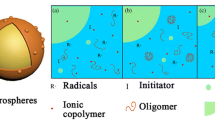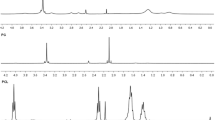Abstract
A process for the coating of polymer microspheres with the same or different polymers and the characterization of these particles is described. Coated microspheres were manufactured from degradable and non-degradable polymers. Several physicochemical methods were used to establish that the particles were fully coated. Polarized light microscopy revealed strong birefringence of coated microspheres resulting in the appearance of Maltese Crosses on coated microspheres. After staining the core and the coating of particles using different fluorescent dyes, the uneven distribution of the dyes in the core and on the surface allows one to verify the coating success. After cutting microspheres using a cryomicrotome we were able to assess the microstructure of the coated microspheres. Electron Spectroscopy for Chemical Analysis (ESCA) was used to determine the surface composition of coated microspheres. Determining the carbon and oxygen content of samples we were able to verify the completeness of the coating procedure. To examine the benefit of coating microspheres, the effect of coating on the release of tetanus toxoid from polylactide microspheres was studied as a possible pharmaceutical application.
Similar content being viewed by others
REFERENCES
Anderson L. C., Wise D. L., Howes J. F., An Injectable Sustained Release Fertility Control System, Contraception, 13:375–384(1976).
Brem H., Mahaley M. S., Vick N. A., Black K. L., Schold S. C., Burger P. C., Friedman A. H., Ciric I. S., Eller T. W., Cozzens J. W., Kenally J. N., Interstitial chemotherapy with drug polymer implants for the treatment of recurrent gliomas. J Neurosurg., 74:441–446(1991).
Mathiowitz E., Langer R., Polyanhydride Microspheres as Drug Delivery Systems. In Donbrow M. (edt.) Microcapsules and Nanoparticles in Medicine and Pharmacy, CRC Press Boca Raton, 1992.
Langer R., Controlled Drug Delivery Systems, Chemical Engineering Communications, 6:1–48(1980).
Sanchez A., Vila-Jato J. L., Alonso M. J., Development of biodegradable microspheres and nanospheres for the controlled release of cyclosporin A, Int. J. Pharm., 99:263–273(1993).
Wang H. T., Schmitt E., Flanagan D. R., Linhardt R. J., Influence of formulation methods on the in vitro controlled release of protein from poly(ester) microspheres, J Contr. Rel., 17:23–32(1991).
Fan L. T., Singh S. K., Controlled release—a quantitative treatment, Springer Verlag, Berlin, 1989.
Tabata Y., Langer R., Polyanhydride microspheres that display near-constant release of water-soluble model drug compounds, Pharm. Res., 10:391–399(1993).
Peppas N. A., Fundamentals of pH and Temperature-Sensitive Delivery Systems. In Gurny R., Junginger H. E., Peppas N. A. (eds) Pulsatile Drug Delivery, Current Applications and Future Trends, APV Paperback Vol. 33, WVG Stuttgart, 1993, pp. 41–56.
Morishita et al. US Patent 3859228.
Gardner D. L., US Patent 4637905.
Schwope A. D., Wise D. L., and Howes T. F., Lactic/Glycolic Acid Polymers as Narcotic Antagonist Delivery Systems, Life Sciences, 17:1877–1886(1975).
Nuwayser et al. US Patent 4568559.
Nuwayser et al. US Patent 4623588.
Mathiowitz et al. US Patent 4861627.
Vrancken M. N., US-Patent 3.523.906.
Vrancken M. N., US-Patent 3.523.907.
Thies C., Characterization of Microcapsules, Proc. 20th Int. Symp. on Contr. Rel. of Bioact. Mat., 20:157–158(1993).
Langer R., Polymers for sustained release of macromolecules: Their use in a single-step method for immunization, Meth. Enzymol., 73:57–75(1981).
M. J. Alonso, S. Cohen, T. G. Park, R. Gupta, G. Siber & R. Langer, Determinants of release rate of tetanus vaccine from polyester microspheres, Pharm. Res., 10:945–953(1993).
Göpferich A., Langer R., The Influence of Microstructure and Monomer Properties on the Erosion Mechanism of a Class of Polyanhydrides, J. Pol. Sci., 31:2445–2458(1993).
Moss M. C. et al., Applications of Confocal Laser Scanning Microscopy in situ Mapping., Analyst, 118:1–9(1993).
Freund H. Handbuch der Mikroskopie in der Technik, 1. Volume, Umschau Verlag, Frankfurt, 1957.
Göpferich A., Gref R., Minamitake R., Shieh L., Alonso M.-J., Tabata Y., Langer R., Drug Delivery from Bioerodible Polymers: Systemic and Intravenous Administration. In Cleland J. and Langer R. (eds) Protein Formulations and Delivery, ACS Symposium Series, 1994, in press.
Author information
Authors and Affiliations
Rights and permissions
About this article
Cite this article
Göpferich, A., Alonso, M.J. & Langer, R. Development and Characterization of Microencapsulated Microspheres. Pharm Res 11, 1568–1574 (1994). https://doi.org/10.1023/A:1018901619230
Issue Date:
DOI: https://doi.org/10.1023/A:1018901619230




